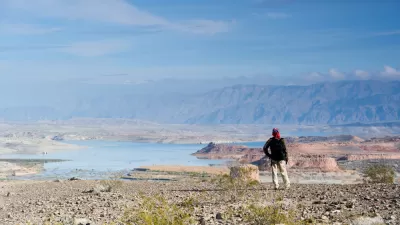The city of Westminster, Colorado has grown from 10,000 in 1962 to 113,000 in the present day, ensuring water supply for the growing population by considering water efficiency in every zoning decision.

Jason Plautz reports on the sustainable development planning practices of the city of Westminster, Colorado, which weathered the controversies of a drought during the summer of 1962 (a sprinkler ban and poor tap water quality inspired a "Mothers' March" and attracted national news coverage) to become a regional leader in water demand management.
In the years that followed the drought, Westminster settled its supply issues, but "continued to focus on taming demand, most recently with a conservation and planning approach that’s become a regional model for managing growth without straining resources."
The key to this approach is a novel approach to land use planning that relies on water data to inform sustainable decision making.
That meant city planners could identify where it might make more sense to zone for multifamily housing, or see where new pipes might be necessary. Developers could amend their permits to include more low-flow toilets or water recycling. On rare occasions, proposals have been scrapped because they’d need more water than the city could supply. Essentially, Westminster is planning for the worst, making sure that another drought won’t force anyone to turn off the taps.
Stu Feinglas, Westminster’s recently retired senior water-resources analyst, serves as a source for soundbites and explanations of the Westminster water-focused planning approach throughout the article.
FULL STORY: The Town That Extended ‘Smart Growth’ to Its Water

Study: Maui’s Plan to Convert Vacation Rentals to Long-Term Housing Could Cause Nearly $1 Billion Economic Loss
The plan would reduce visitor accommodation by 25,% resulting in 1,900 jobs lost.

Alabama: Trump Terminates Settlements for Black Communities Harmed By Raw Sewage
Trump deemed the landmark civil rights agreement “illegal DEI and environmental justice policy.”

Why Should We Subsidize Public Transportation?
Many public transit agencies face financial stress due to rising costs, declining fare revenue, and declining subsidies. Transit advocates must provide a strong business case for increasing public transit funding.

Paris Bike Boom Leads to Steep Drop in Air Pollution
The French city’s air quality has improved dramatically in the past 20 years, coinciding with a growth in cycling.

Why Housing Costs More to Build in California Than in Texas
Hard costs like labor and materials combined with ‘soft’ costs such as permitting make building in the San Francisco Bay Area almost three times as costly as in Texas cities.

San Diego County Sees a Rise in Urban Coyotes
San Diego County experiences a rise in urban coyotes, as sightings become prevalent throughout its urban neighbourhoods and surrounding areas.
Urban Design for Planners 1: Software Tools
This six-course series explores essential urban design concepts using open source software and equips planners with the tools they need to participate fully in the urban design process.
Planning for Universal Design
Learn the tools for implementing Universal Design in planning regulations.
Smith Gee Studio
Alamo Area Metropolitan Planning Organization
City of Santa Clarita
Institute for Housing and Urban Development Studies (IHS)
City of Grandview
Harvard GSD Executive Education
Toledo-Lucas County Plan Commissions
Salt Lake City
NYU Wagner Graduate School of Public Service





























